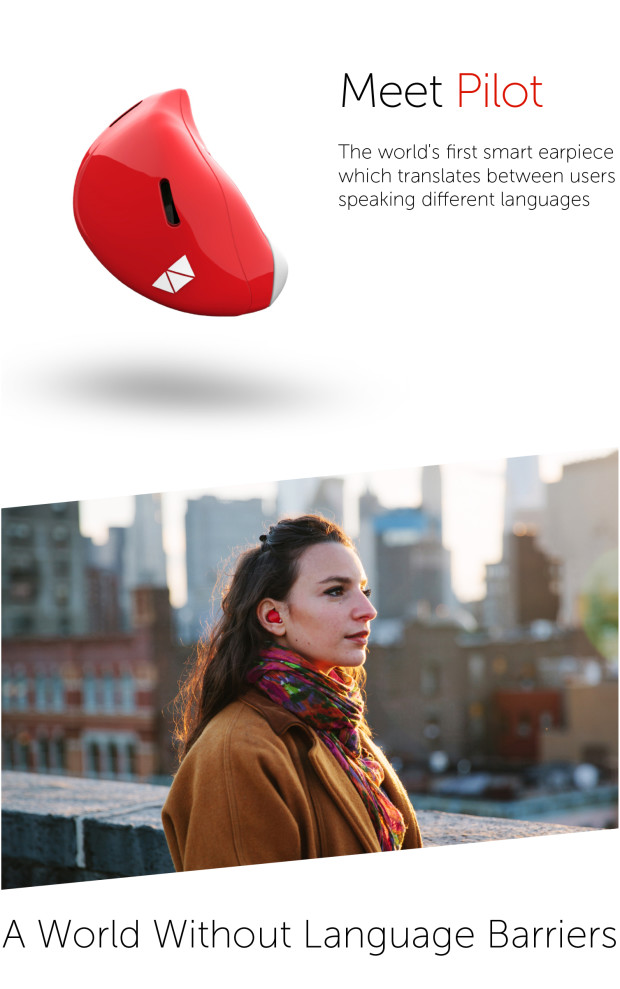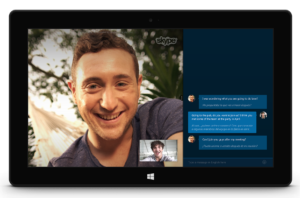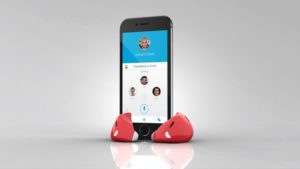Ear Translator May Create A World Without Language Barriers : A Well Thought Out Scream by James Riordan

I have a buddy in Taiwan that makes a pretty good living teaching English as a second language. He should probably keep his ears open for the possibility of another career. I say ears because the device that may put him and other language teachers out of a job is tiny translator that goes in your ear. Created by Waverly Labs, a US-based company, the translator is is called The Pilot System. The Pilot does all of the translating for you. It even translates what you say into the other person’s language. As a result, two people can seamlessly enjoy a conversation without speaking the same language. This is a gadget straight out of science fiction. All you need, according to the company, are the Pilot earpieces and a smartphone app. While the details are currently scarce, it’s likely the ear pieces will pick up your voices, send it to the app via Bluetooth, and then come out as translated speech in the other person’s ear.
From Gene Roddenberry in Star Trek to Douglas Adams in The Hitchhiker’s Guide to the Galaxy, anyone who spends much time forecasting the future comes to realize that language is a huge barrier. In a connected world, it’s one of the only things remaining that truly separates us — it’s what keeps keeps us from being able to directly consume and understand one another’s film and literature, and what keeps occupying soldiers from being able to effectively make alliances with local peoples. It’s a primitive relic of a bygone age — if we can convert MP4 to AVI, certainly we ought to be able to convert Mandarin to German.
The Pilot is a real-world Babelfish, the name of the exotic fish in A Hitchhiker’s Guide to the Galaxy book and film that once you drop it into your ear, allows you to understand any language. The Pilot is a or universal translator and you don’t have to endure the squirmy-mirmy feeling of having a fish in your head.
While the concept of a universal translator sounds pretty cool, it isn’t exactly new technology. Microsoft has its Skype Translator, which takes speech, translates it to text, and then audibly speaks it back to the other person. This isn’t entirely useful if you’re out having a conversation in person with someone, but the speech translation engine exists. There is also Google Translate’s conversation mode, which automatically detects which language is being spoken and translates it out loud. It requires a phone to be positioned between the two speakers and could pick up a lot of unwanted noise, though.
 So, while the idea of a universal translator has been around for some time, the actual invention has been slow in com-ing. One major reason is that real-time translation is hard. It’s so hard, in fact, that all the advancement in computing power we’ve seen in the past 20 years did little to get us closer to the goal. It took a revolution in how we compute information, the influx of neural network models and machine learning algorithms, before we could crunch natural language and produce a translation in a reasonable amount of time — but there’s still a problem. Neural networks are themselves very hard to run, meaning we need a super-computer to do translation. We’ve got speech recognition, and we’ve got translation, and we’ve even got both of those things in real-time in some very specific cases, but a portable, near-real-time translation device that moves with you? Despite rumors of GoogleX super-projects, it hasn’t until now.
So, while the idea of a universal translator has been around for some time, the actual invention has been slow in com-ing. One major reason is that real-time translation is hard. It’s so hard, in fact, that all the advancement in computing power we’ve seen in the past 20 years did little to get us closer to the goal. It took a revolution in how we compute information, the influx of neural network models and machine learning algorithms, before we could crunch natural language and produce a translation in a reasonable amount of time — but there’s still a problem. Neural networks are themselves very hard to run, meaning we need a super-computer to do translation. We’ve got speech recognition, and we’ve got translation, and we’ve even got both of those things in real-time in some very specific cases, but a portable, near-real-time translation device that moves with you? Despite rumors of GoogleX super-projects, it hasn’t until now.
One major problem has been that, in order for a translator to be wearable and move with you, you would need an always-on data connection, which would require a hefty power supply to keep the connection going all day. The Pilot gets around this by wirelessly accessing your cell phone’s processor to do the work locally and while previous on-phone translation services have been imperfect, Pilot claims to have reached true real-time speeds.
 What this does to your cellphone’s battery is anybody’s guess, but I’d bet this sort of intensive crunching would burn through even giant Galaxy S-series batteries in a short time. It’s not exactly living “untethered” if you have to plug your phone in every 45 minutes, but sci-fi beggars can’t be choosers, and the early adopters who buy one of these for a cool $300 will still be able to feel like they’re legitimately at the forefront of a tech revolution.
What this does to your cellphone’s battery is anybody’s guess, but I’d bet this sort of intensive crunching would burn through even giant Galaxy S-series batteries in a short time. It’s not exactly living “untethered” if you have to plug your phone in every 45 minutes, but sci-fi beggars can’t be choosers, and the early adopters who buy one of these for a cool $300 will still be able to feel like they’re legitimately at the forefront of a tech revolution.
The other problem that has held back universal translators is that there are so many practical concerns. Do you turn it on only when you need it, and if so aren’t you going to miss a lot of the unexpected banter that you’d want to hear? How does it know who you’re talking to, in a crowded room full of people speaking? How does it fit on my head?
 Pilot gets around these problems by splitting the service into two pieces. It’s not actually an earpiece, but two earpieces. When you’ve decided you want to talk to somebody (like the dreamy French girl who allegedly inspired this thing), you simply hand them their ear-piece to begin talking. Each of you now has a translator, so you can both understand one another — this takes the place of any sort of speaker that most sci-fi translators use to say our words out loud.
Pilot gets around these problems by splitting the service into two pieces. It’s not actually an earpiece, but two earpieces. When you’ve decided you want to talk to somebody (like the dreamy French girl who allegedly inspired this thing), you simply hand them their ear-piece to begin talking. Each of you now has a translator, so you can both understand one another — this takes the place of any sort of speaker that most sci-fi translators use to say our words out loud.
 So, it’s not quite a “put it in your ear and it’s like everyone’s speaking English” super-invention, and since this came out of an indiegogo campaign, you wouldn’t really expect it to. But it is incredibly ambitious, and it could spark existing translation efforts from Skype (Microsoft) and Google to shoot a little higher, a little faster.
So, it’s not quite a “put it in your ear and it’s like everyone’s speaking English” super-invention, and since this came out of an indiegogo campaign, you wouldn’t really expect it to. But it is incredibly ambitious, and it could spark existing translation efforts from Skype (Microsoft) and Google to shoot a little higher, a little faster.
Consumer-level wearable real-time translation could be one of the most disruptive technologies in recent memory, breaking down old cultural barriers, accelerating globalization, and, yes, letting you talk to French girls. It can’t come fast enough.
Whenever I’m traveling to a country that speaks a different language, many people try and learn a few phrases in advance, but that plan usually crashes about five minutes after they step off the plane and discover that no one they speak to has a clue what they’re saying. Being lost in translation has happened to everyone while traveling, and that’s exactly how the idea was born. Waverly Labs is at the convergence of wearable technology + machine translation, developing the world’s first smart earpiece language translator. Using the latest technologies in speech recognition, machine translation and the advances of wearable technology, the earpiece allows wearers to speak different languages but still clearly understand each other. Simply put, when one person speaks, the other hears it in their language.
 However, because the Pilot requires two earpieces, it will likely only capture the voice of the person wearing it, which already makes it better than Google Translate for regular use in the real world — that is, as long as the translation engine is as good as Google’s or better.
However, because the Pilot requires two earpieces, it will likely only capture the voice of the person wearing it, which already makes it better than Google Translate for regular use in the real world — that is, as long as the translation engine is as good as Google’s or better.
The Pilot is the world’s first language-translating earpiece. It works in pairs, meaning you wear one earpiece and the person you’re speaking with wears the other. From there, your speech will be translated almost immediately to the other wearer’s language, which they’ll hear in their earpiece.
The internet went nuts for Pilot, a real time translation hearable, this week. It’s not the first time in the past few years that people have cried ‘Babel Fish!’ – most recently for Skype’s Translator feature, which started rolling out in beta for seven languages at the end of 2015. Microsoft’s efforts are impressive but still a way off allowing us to have real time Skype conversations in multiple languages.
 So can Waverly Labs, a New York startup made up of six people, and its founder Andrew Ochoa, do any better? The first video Waverly put out to promote the device it put out appears to show the wireless hearable, which includes a microphone to capture audio from the person you’re speaking to, translating between French and English in real time. The company’s Media Kit says the earpiece “will be out by Spring 2017” following the launch of an Indiegogo campaign and mobile app in 2016. By the usual crowdfunding rule, we’d expect then for units to ship by the end of 2017.
So can Waverly Labs, a New York startup made up of six people, and its founder Andrew Ochoa, do any better? The first video Waverly put out to promote the device it put out appears to show the wireless hearable, which includes a microphone to capture audio from the person you’re speaking to, translating between French and English in real time. The company’s Media Kit says the earpiece “will be out by Spring 2017” following the launch of an Indiegogo campaign and mobile app in 2016. By the usual crowdfunding rule, we’d expect then for units to ship by the end of 2017.
Pilot will cost $299 at the full retail price but Waverly Labs has indicated that the Indiegogo price could be more like $249, or lower. The price includes a second wireless earbud which can be used for music, a charging case and some languages (English, French, Spanish, Italian currently supported) – others will be purchased separately when available, including “East Asian, Hindi, Slavic and Semitic languages”.
A small startup, with enough cash and talent, could build a wireless earbud with a microphone by mid to end 2017. That’s not the tricky part.
Andrew Ochoa told Forbes the following: “We’re building a hybrid system. Some of it’s licensed and some we’ve built ourselves. We don’t want to make any promises or references that this is incredibly real-time or that we could give you an earpiece and drop you off in the middle of Tokyo. That is not what we’re trying to convey at all.”
So Waverly’s six person team isn’t doing all the work itself, maybe it’s using open source work on speech recognition and translation and paying for other research and patented systems. That’s more promising. And, despite that video, it’s not “incredibly real time”. Slow that hype machine down.
 For anyone who has actually looked into what’s out there, another pressing question is can it out translate Skype? Again, Ochoa himself is downplaying expectations. ” lags much more than Skype’s latest translation engine does…they are using,” he said. “I’m not saying we built something comparable to that.”
For anyone who has actually looked into what’s out there, another pressing question is can it out translate Skype? Again, Ochoa himself is downplaying expectations. ” lags much more than Skype’s latest translation engine does…they are using,” he said. “I’m not saying we built something comparable to that.”
He stresses the packaging and “combining” of technologies suggesting that Pilot will live or die on other tech outside of Waverly Labs. Presumably, the Pilot mobile app will give it more voice data to work with, just as Google Translate, Skype and Nuance’s various voice assistant apps give these companies more material to help improve their machine learning algorithms, the more people use them. But we can’t imagine that an Indiegogo campaign, even with this hype, would generate the numbers needed to make this really game changing.
Pilot’s translation platform is at the “late alpha” stage and Waverly Lab’s CEO says there is still a lot of testing to be done. The best idea we will have of what the earbud will offer is when the mobile app is launched later in 2016. Or, you know, when we get to try it out for reals.
Andrew Ochoa, the founder and CEO of Waverly Labs, describes himself as a “tech futurist, entrepreneur, autodidact, sojourner, blogger” in his Twitter bio (back when he only had 162 followers). He founded Waverly Labs in October 2013, according to his LinkedIn profile, and the only other job he’s chosen to share is a sales and product development consultant role. The rest of the team includes an electrical engineer named Bill, who has visited manufacturers in Shenzhen, but Waverly Lab’s “Team” page doesn’t provide much more info on the backgrounds of other employees, apart from a few photos. Investment so far has been from “family and friends” but Ochoa is reportedly in talks with investors.
Waverly Labs intends to answer everyone’s questions as well as posting more videos showing the device in action.
Let’s just say this device has the potential to change the world in a really big way. Sorry professional translators, but it looks like technology is trying to snag your career.
The Pilot earpiece by Waverly Labs is set to launch this fall now that its Indiegogo crowdfunding campaign is complete.
At last, someone has invented a small, easy-to-use device that removes all language barriers.





No Comment